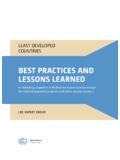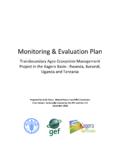Transcription of Career development in best-practice organizations ...
1 A DOSSIER ON Career development . Career development in best -practice organizations : critical success factors Natalie Lam, In every organization we examined, the Lorraine Dyke and message is clear: Career development is Linda Duxbury employee owned, manager facilitated and organization supported. reflect on their own Career development practices;. O. ne of the ways progressive employers have sought to make improvements in their people manage- identify, define and refine a set of Career development ment is through benchmarking their practices processes and practices that will contribute to organ- against the progress of other firms. Benchmarking embod- izational success and employee growth; and ies the idea that it is possible to examine the best practices of other organizations and then implement changes based implement changes based on these reflections and on these observations.
2 Fitz-Enz, the guru of benchmarking, observations. formally defines benchmarking as a continuous systematic This article will first provide a description of the process for evaluating business practice and organizations methodology used to conduct the study. This is followed that are recognized as examples of best -in-class through by a short discussion of the reasons private sector organ- organizational comparison. 1 He views it as an iterative, izations are interested in Career development . The rest investigative process that seeks out high performers to learn of the article is devoted to summarizing the major how they have achieved exceptional results. This article lessons learned and the critical success factors for effec- presents some of the conclusions drawn from the study tive Career development identified by the best -practice which benchmarked the human resources (HR) practices of organizations .
3 A number of organizations considered to be on the leading edge of Career development . The objectives of the bench- marking study were to allow federal policy makers to: Methodology examine and learn from these best -in-class Career Fourteen organizations were identified and in-depth management and Career development companies;. interviews were held with individuals responsible for Career reflect on the appropriateness of the best practices in management and Career development programs in each their own context; organization. The employers featured in this study were 22 Optimum, The Journal of Public Sector Management Vol. 29, No. 4 (22-30). A DOSSIER ON Career development . selected on the basis of their outstanding reputations in the This article will highlight the lessons to be learned Canadian Career management arena.
4 The organizations from these organizations and the critical success factors, were chosen on the basis of having been profiled or identi- with particular focus on the private sector companies. fied as best -in-class, progressive organizations ( , one of Financial Post's 100 best companies to work for in Canada, or a government department with a reputation for innovative Career development programs). Why are private sector companies interested in The interviews were conducted by one researcher to ensure consistency. Information was obtained through these Career development ? in-depth interviews, written policy summaries, guidelines The development of people has taken centre stage as and other material provided by those who were inter- a crucial business strategy in the 1990s for many organiza- viewed.
5 Although a structured, 26-question script was tions. Many companies have realized that in the global prepared for each interview, the perspectives of these orga- economy, leveraging their workforces' talents and skills nizations proved so diverse that it was decided that more is the chief means of staying competitive. Since staying insights could be obtained if the researcher did not limit the ahead of the technological game is very transient, the respondents to particular topics but instead encouraged quality, innovativeness and commitment of its human them to explore what they deemed to be critical. On aver- resources are what make the difference in terms of a com- age, each interview lasted at least three hours. Many of petitive edge.
6 There is recognition that people the organizations were very generous with their time. For development must necessarily be closely aligned with the some organizations , several individuals responsible for strategic business needs of the organization. Employees'. different aspects of the Career development system were Career plans and their developmental needs must be con- interviewed, each spending on average two to three hours sciously linked with the organization's workforce needs as with the researcher. Not only were the participants coopera- well its strategic direction. In today's lean and mean'. tive, they were also candid and informative, and their business climate, development is a necessary survival strat- responses were comprehensive and provided extensive egy: it helps companies position themselves so they can documentation for reference purposes.
7 Adjust to rapid changes in their environment.. Of the 14 organizations , one was a Crown corpora- development processes enable companies to meet such tion: Business development Bank of Canada; five were challenges quickly and effectively. Organizational public sector organizations : Health Canada, National Career development [is] a strategic process in which maxi- Research Council, Statistics Canada, Treasury Board of mizing individuals' Career potential is a way of enhancing Canada and the Ontario Public Service; and eight were the success of the organization as a whole. 2 Many compa- private sector companies: nies have come to realize that developing people is cen- tral to organizational effectiveness. It is also a key factor as Alcan Aluminum organizations compete for human resources that are Bank of Montreal skilled and scarce.
8 This is clearly reflected in the com- ments of one person interviewed: Bell Canada One of the key differentiators for an organization to become an employer of choice now and in the future is the amount Hewlett-Packard Canada of avant-garde strategic development you do so that people will be learning the newest things that need to be learned in IBM Canada whatever field. This is the value that people are looking for in terms of corporate development or institutional develop- Pratt & Whitney Canada ment in any organization. Offering Career resiliency and offering opportunity to learn the best will be the attraction for Royal Bank of Canada people coming into the job market. That's what they are look- ing for. They're looking for companies that will give them Xerox Canada.
9 Career resiliency. Optimum, The Journal of Public Sector Management Vol. 29, No. 4 23. A DOSSIER ON Career development . Lessons learned and critical best -practice organizations invest success factors in Career development best -practice organizations are also willing to invest in From the in-depth interviews and the company docu- the Career development process: to back up their vision of a mentation provided, it is obvious that while the Career Career -resilient workforce that is committed to the organiza- development strategies and programs vary extensively tion's success with actual commitment in financial, human across the organizations in this study,3 there were also and technical resources. IBM, for example, was willing to common threads in philosophy, objectives and practices invest $1 million to get the Career Vitality Centre (now among the participating organizations .)
10 The following called CareerNet) in operation in January 1997 to bring will highlight the critical success factors identified by the together almost all of the vital services and information that participating companies. employees need for assistance in Career management ( , self-assessment tools; Career counselling; workshops;. library of books, audios, videos, job news, competency pro- Top management commitment files, etc.). In the same year, IBM invested $22 million in employee development (with $12 million on training alone). and support is key There are other examples: There is almost uniform consensus that perhaps the most important factor contributing to the success of any Xerox Canada has a $10-million training budget; an Career management and Career development system is top additional $500,000 is allocated to self-directed management's commitment and support It is the abso- learning.






